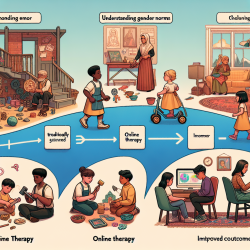Exploring the Impact of Gender Norms on Child Development
As practitioners in the field of speech-language pathology, we often encounter various social determinants that influence child development. One such determinant is gender norms, which are the societal expectations for behaviors deemed appropriate for men and women. Understanding these norms is crucial for creating effective interventions and fostering positive outcomes for children.
The Research Behind Gender Norms
Recent research, specifically the study titled Evaluating the Validity and Reliability of the Gender Equitable Men’s Scale Using a Longitudinal Cohort of Adolescent Girls and Young Women in South Africa, provides valuable insights into how gender norms affect health outcomes. This study utilized the Gender Equitable Men’s Scale (GEMS) to assess gender norms among adolescent girls and young women in South Africa, focusing on the reliability and validity of the scale over time.
Key Findings and Implications
The study found that the GEMS is a reliable tool for measuring gender equitable beliefs longitudinally. However, it also highlighted that certain items on the scale showed bias, influenced by factors such as age, pregnancy, sexual debut, and intimate partner violence. This suggests that while the GEMS can provide a general measure of gender norms, individual items may require adaptation to account for specific experiences.
For practitioners, these findings underscore the importance of considering the broader social context when assessing and planning interventions for children. By understanding the role of gender norms, we can tailor our approaches to better address the unique needs of each child, promoting more equitable and effective outcomes.
Practical Applications for Practitioners
- Assess the Influence of Gender Norms: Regularly evaluate how gender norms might be impacting the children you work with. This can help in identifying potential barriers to effective communication and learning.
- Adapt Interventions: Use the insights from the GEMS study to adapt your interventions, ensuring they are culturally sensitive and account for the child's lived experiences.
- Promote Gender Equity: Encourage practices and activities that promote gender equity, helping children to develop a more balanced understanding of gender roles.
- Engage in Further Research: Consider conducting or participating in further research to explore the impact of gender norms in your specific context, contributing to a broader understanding of these dynamics.
Conclusion
Understanding and addressing gender norms is crucial for creating positive outcomes in child development. By integrating the findings from the GEMS study into our practice, we can enhance our interventions and support children in achieving their full potential. For more detailed insights, I encourage you to read the original research paper.
To read the original research paper, please follow this link: Evaluating the Validity and Reliability of the Gender Equitable Men’s Scale Using a Longitudinal Cohort of Adolescent Girls and Young Women in South Africa.










